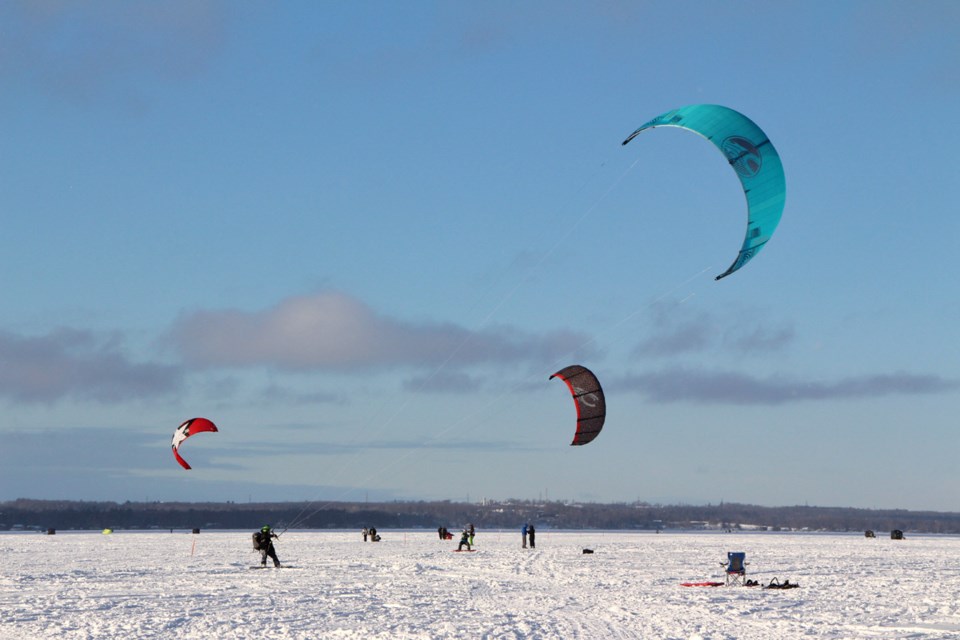Have you noticed the eye-catching spectacle on area lakes this winter? On certain days, especially windy ones, you may see dozens of colourful, large kites flying above the frozen lakes.
It’s called snowkiting – a winter sport using a kite and wind power to glide on snow. It is similar to kitesurfing on water, except, instead of a surf or kiteboard, the footwear is a pair of skis or a snowboard.
Snowkiter Dave “Kite Guy” Young runs a WhatsApp group to connect snowkiters and kitesurfers and Mark Chandler is an avid snowkite skier. While Chandler snowkites on his skis, Young uses a snowboard. Both say they are addicted to the sport.
So, what is this sport all about?
“Once you start, it’s addictive,” says Young. “When you start feeling the power of the wind, there’s nothing else like it. It’s quiet, and you’re just coasting; it’s almost like flying. It’s a big thrill.”
Chandler says the word “addictive” is a good description of the sport, saying that it’s the feeling of freedom that such a simple thing as a kite can give you. “There’s a bit of a learning curve, but once you’ve figured it out, you’re hooked!”
How did you get involved?
Young and Chandler, both in their 50s, were always active in sports, but didn’t take up kiting until more recently, and when they did, it was on the water. Then they discovered snowkiting as a way to get out and be active during the winter months.
Young explained that most snowkiters (likely about 90 per cent) are also kite boarders in the summer.
“I’ve always been a downhill skier,” said Young, but never snowboarded until I took up boarding behind a kite this winter.”
Chandler says the skills he picked up in other sports, such as water skiing, sailing and flying, have all come together to help him enjoy the sport of kite surfing and boarding.
“I find that snowkiting is something I can enjoy for hours on end. It’s not as physically demanding and tiring as many other sports and, unlike downhill skiing, there is no waiting in lines or sitting on chairlifts,” he explained.
How do you get started as a beginner?
“Really, what you have to learn to do is fly a kite,” said Young. “It’s pretty basic, you have a big kite with four lines that are all attached to a control bar on your harness, which goes around your waist. The two outer lines are used for steering.”
Chandler adds that the sport is about 80 per cent kite flying skill and 20 per cent ski or snowboarding skill. “Knowing how to sail and understanding wind is also helpful.”
Both Young and Chandler stressed the importance of taking lessons, especially to learn about safety.
“It can get quite dangerous,” said Young, “especially if you get gusty winds.” He said certified instructors can be found by doing a simple Internet search, or through word of mouth.
What kind of equipment do you need?
“Well, I have 16 kites – big kites for light winds, small kites for strong winds and everything in between,” explained Young.
Young admits that he has quite the collection of gear. He also has 12 or 13 different boards to suit different conditions. The good news is that you use the same kites on the snow as you do on the water.
In addition to the kites, boards and skis, essential equipment also includes your harness and control bar. You may also need a pump. There are two kinds of kites: an air-filled kite, with a bladder that is pumped up; and a “foil,” often used for lighter winds.
Like any sport, the sky seems to be the limit (no pun intended) when it comes to kiting.
For Young, who last year kited 160 times (almost every second day), being able to choose the right equipment for the day is important. But he stresses, for the beginning snowkiter, you just need the basics – kite, harness and control bar, along with your skis or snowboard.
Where are your favourite spots to snowkite?
“Wherever there is wind!” both Young and Chandler responded. “The direction of the wind determines the best location.”
“Actually, here on Lake Couchiching is one of our favourite spots to snowkite,” said Young. “When the conditions are right, with wind speeds of eight to ten knots, it’s fantastic.”
Do you consider snowkiting to be an extreme sport?
Although there are extreme aspects to the sport, especially when an accomplished kiter performs jumps and flips, both Young and Chandler say it’s a sport that is accessible to a wide range of ages and fitness levels.
“We have a great community of kiters,” explained Young. “Most of the people I kite with are my age, but we have lots of younger kiters as well as some in their 70s. And there’s just as many females.”
“The sport doesn’t require a lot of strength,” said Chandler. “It’s more about balance, enjoying the wind and the thrill of the ride.”
“When you learn to dive the kite into the power window; you just keep it there and start going; it’s really fun,” added Young.



